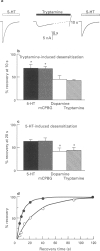Abstract
1. 5-Hydroxytryptamine 5-HT3 receptor-mediated ion currents evoked by 5-HT, quaternary 5-HT (5-HTQ), meta-chlorophenylbiguanide (mCPBG), dopamine and tryptamine in N1E-115 mouse neuroblastoma cells have been investigated in whole-cell voltage clamp and single channel patch clamp experiments. 2. The concentration-dependent activation and desensitization of the ion currents evoked by the agonists yield the potency order: mCPBG > 5-HTQ approximately 5-HT >> tryptamine > dopamine, and the efficacy order: 5-HT approximately mCPBG approximately 5-HTQ >> dopamine approximately tryptamine. Thus, 5-HT, 5-HTQ and mCPBG are full agonists, whereas dopamine and tryptamine are partial agonists at the 5-HT3 receptor. 3. Full and partial agonists cause complete cross-desensitization and activate single channels with similar conductances and open lifetimes. This shows that full and partial agonists act on the same population of 5-HT3 receptors. 4. The time course of recovery from desensitization depends on the agonist used. Recovery from partial agonist-induced desensitization is single exponential, whereas the desensitization induced by full agonists recovers with sigmoid kinetics, suggesting at least 3 steps between 4 states. 5. During the process of recovery from cross-desensitization, the full agonists activate a larger fraction of the 5-HT3 receptors than the partial agonists, irrespective of the agonist used to induce desensitization. 6. It is concluded that full and partial agonists induce distinct desensitized states and, during recovery from desensitization, recognize distinct conformations of unoccupied 5-HT3 receptors. This conformational selection is likely to account for the different efficacies of full and partial 5-HT3, receptor agonists.
Full text
PDF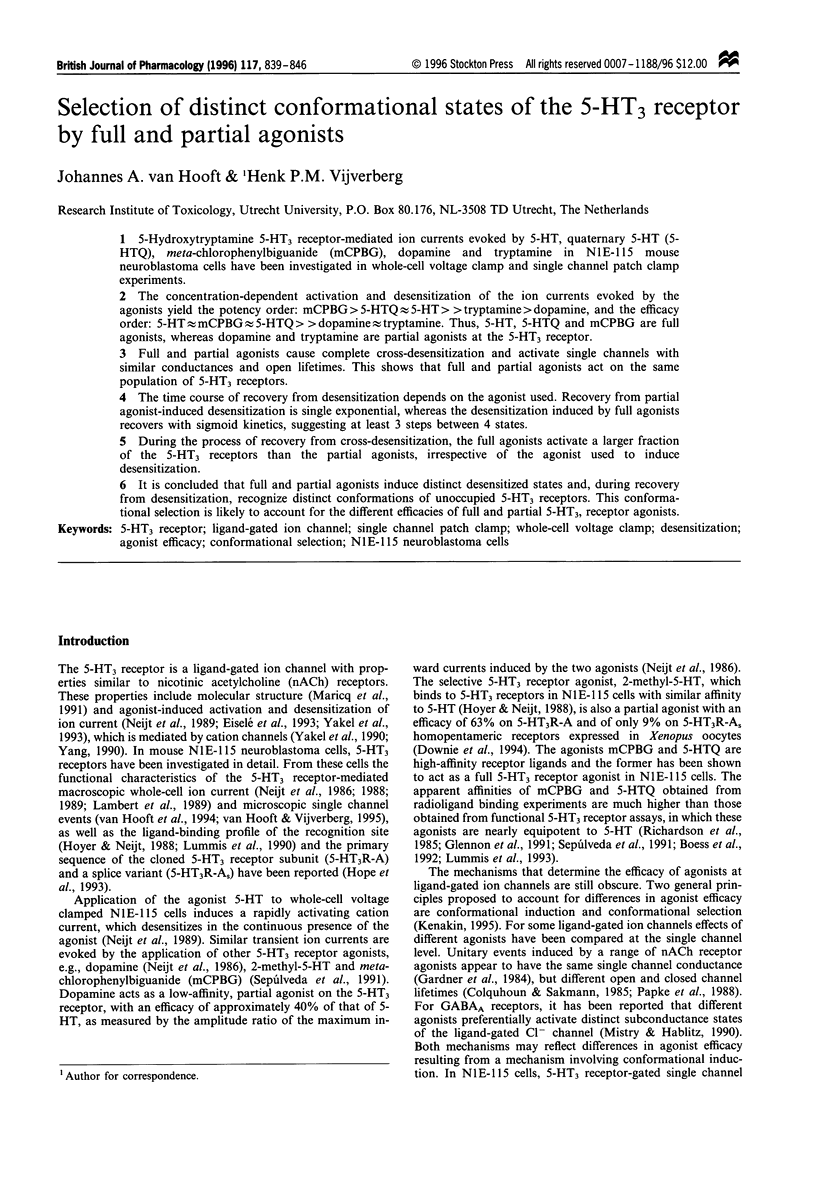
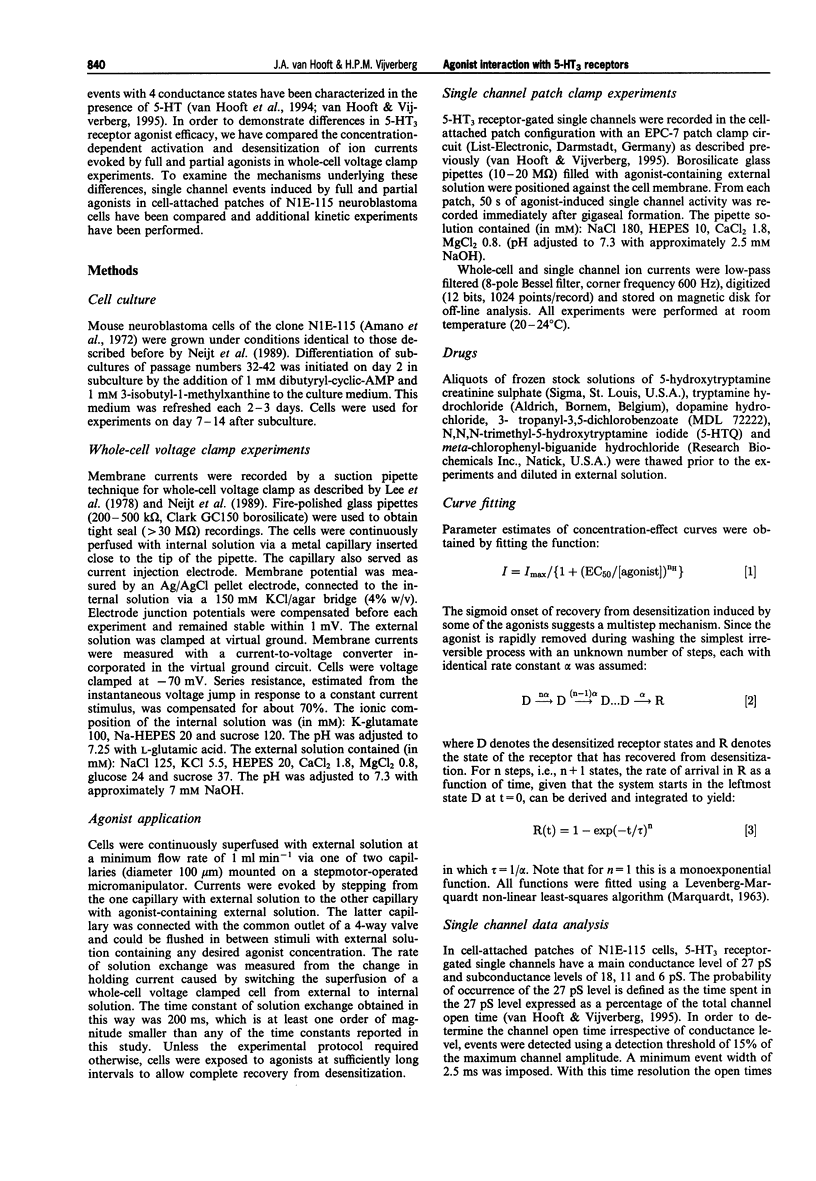
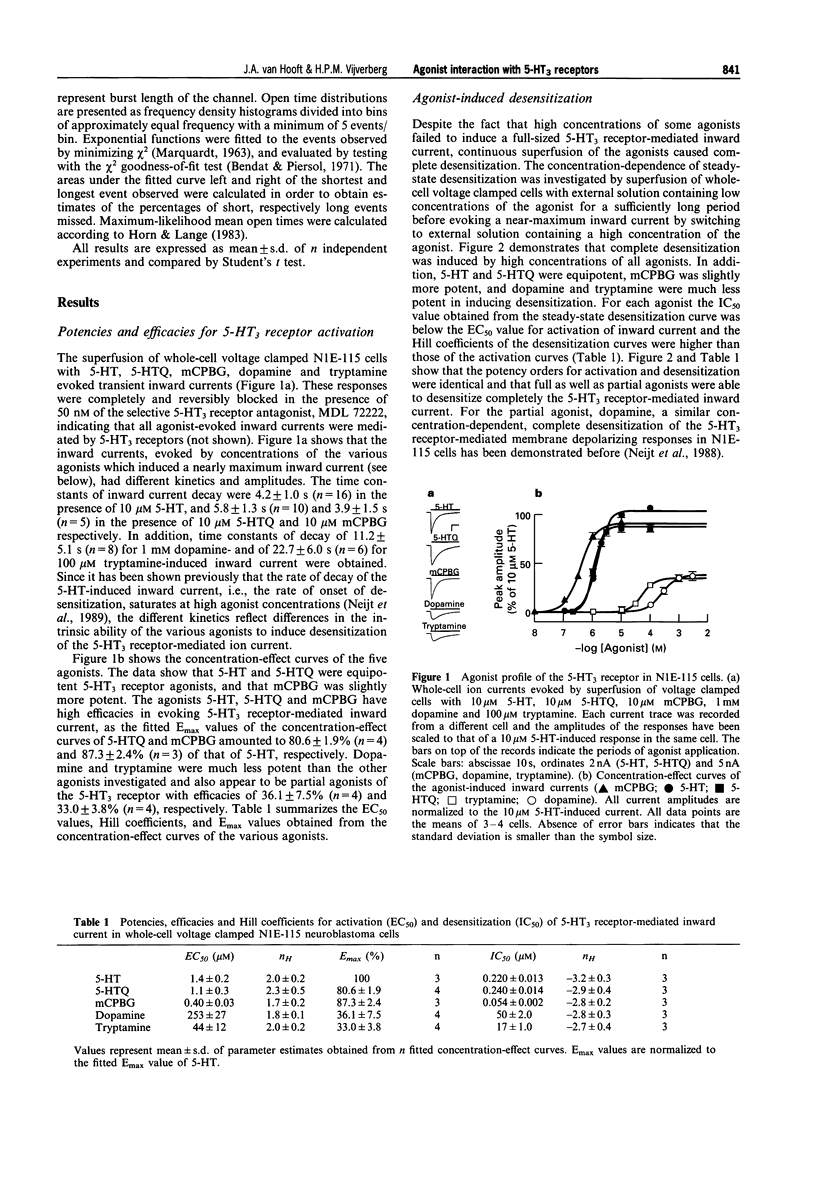

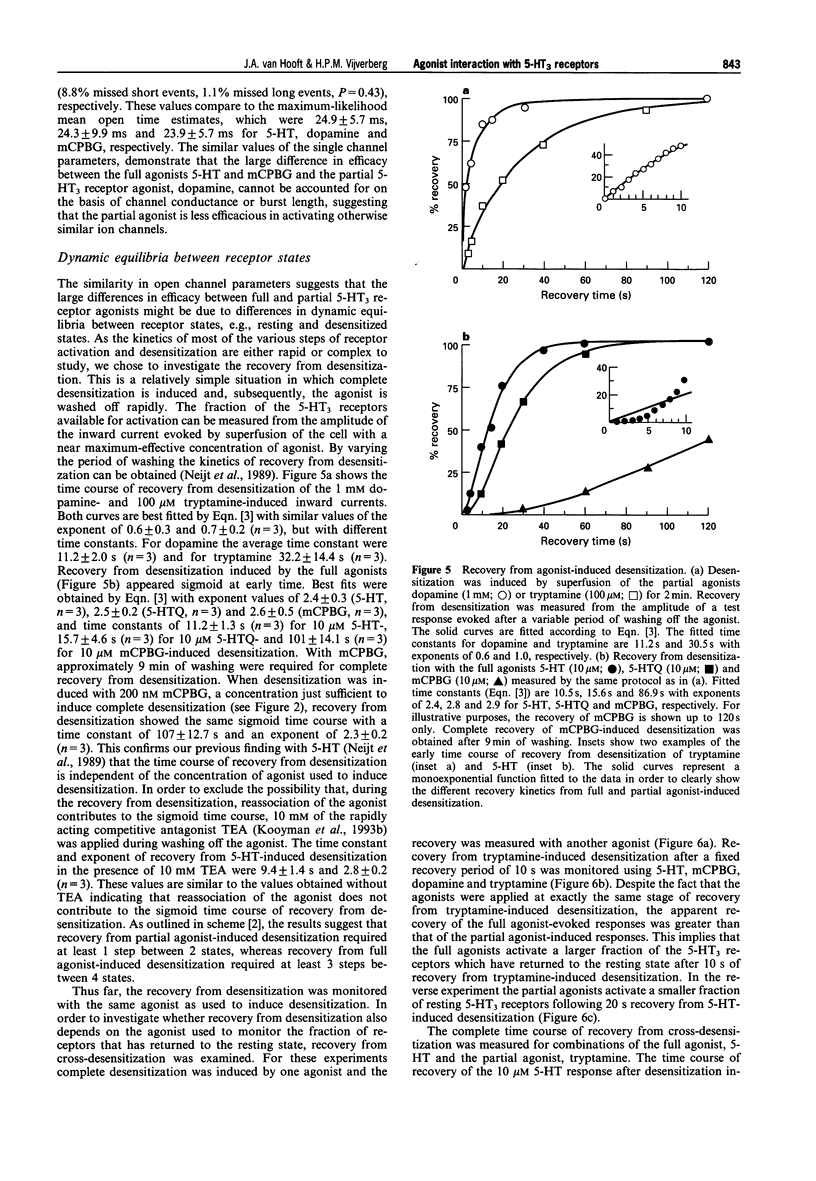
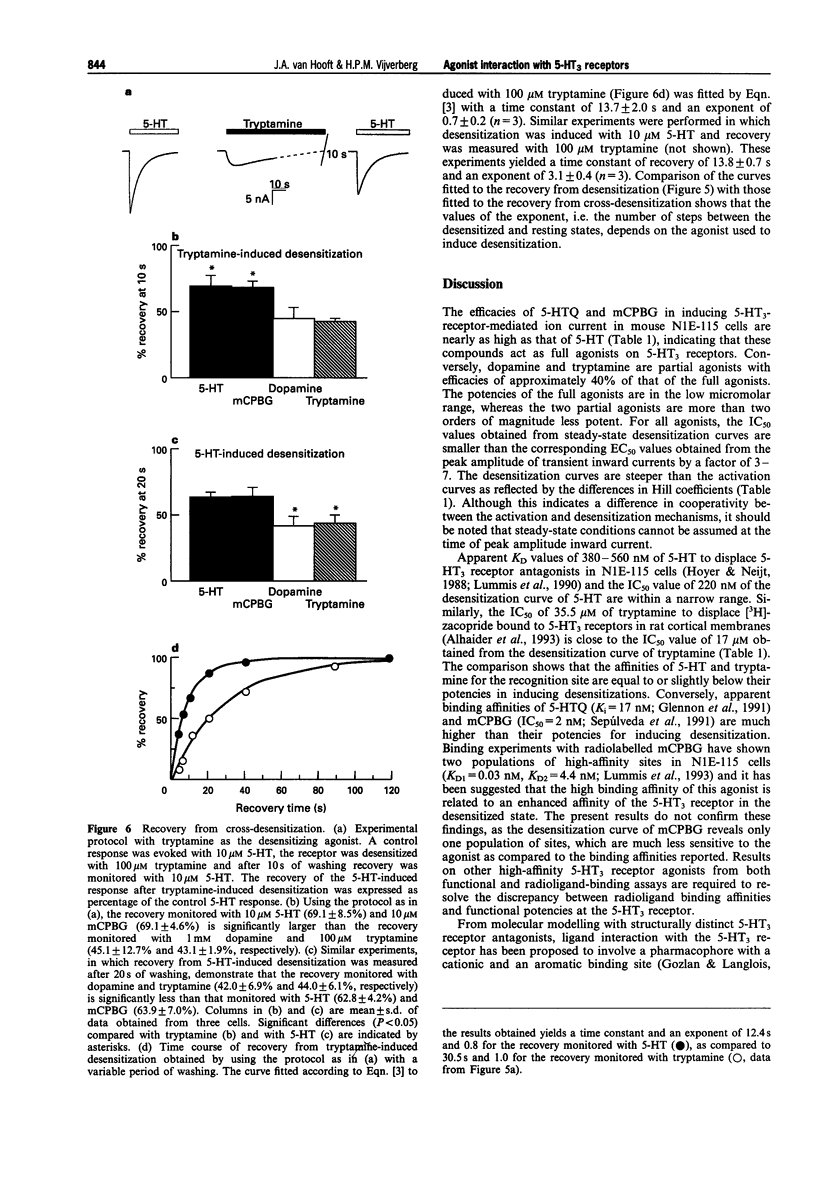
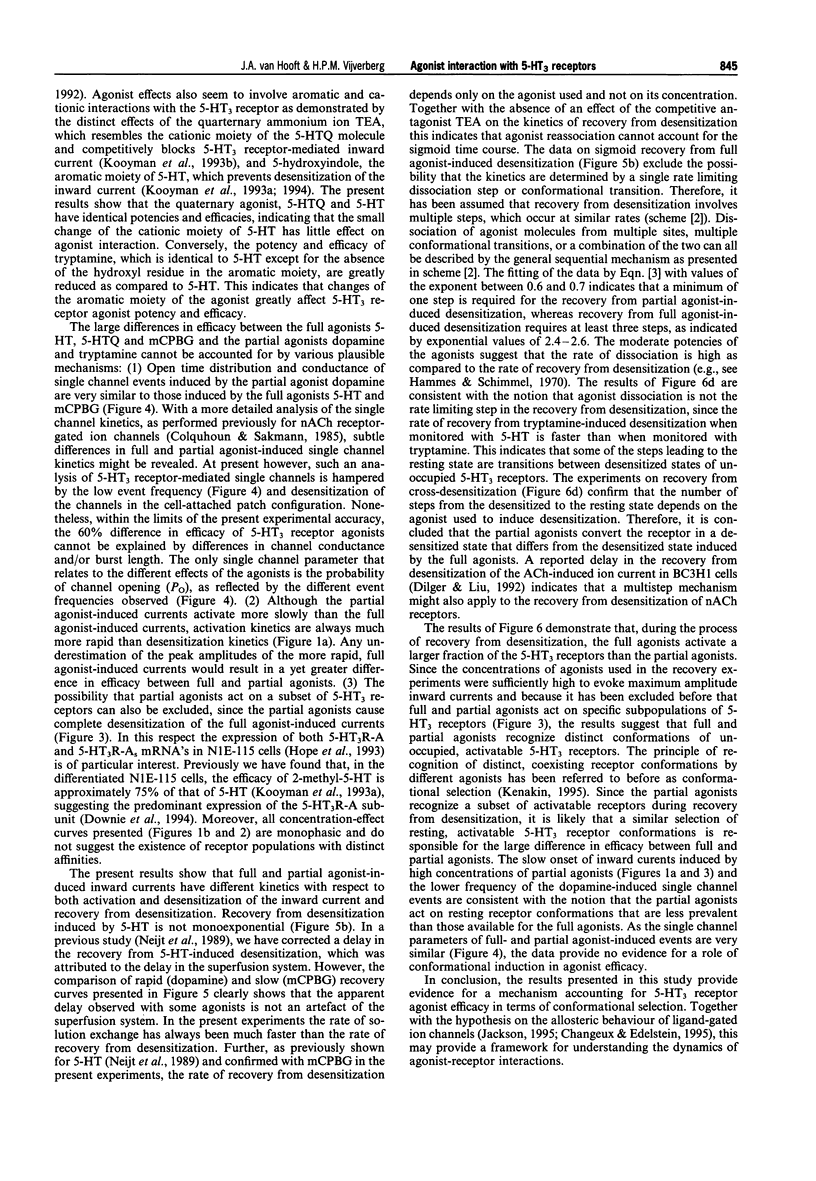

Images in this article
Selected References
These references are in PubMed. This may not be the complete list of references from this article.
- Alhaider A. A., Hamon M., Wilcox G. L. Intrathecal 5-methoxy-N,N-dimethyltryptamine in mice modulates 5-HT1 and 5-HT3 receptors. Eur J Pharmacol. 1993 Nov 9;249(2):151–160. doi: 10.1016/0014-2999(93)90427-j. [DOI] [PubMed] [Google Scholar]
- Amano T., Richelson E., Nirenberg M. Neurotransmitter synthesis by neuroblastoma clones (neuroblast differentiation-cell culture-choline acetyltransferase-acetylcholinesterase-tyrosine hydroxylase-axons-dendrites). Proc Natl Acad Sci U S A. 1972 Jan;69(1):258–263. doi: 10.1073/pnas.69.1.258. [DOI] [PMC free article] [PubMed] [Google Scholar]
- Boess F. G., Sepúlveda M. I., Lummis S. C., Martin I. L. 5-HT3 receptors in NG108-15 neuroblastoma x glioma cells: effect of the novel agonist 1-(m-chlorophenyl)-biguanide. Neuropharmacology. 1992 Jun;31(6):561–564. doi: 10.1016/0028-3908(92)90188-u. [DOI] [PubMed] [Google Scholar]
- Changeux J. P., Edelstein S. J. On allosteric mechanisms and acetylcholine receptors. Trends Biochem Sci. 1994 Oct;19(10):399–400. doi: 10.1016/0968-0004(94)90084-1. [DOI] [PubMed] [Google Scholar]
- Colquhoun D., Sakmann B. Fast events in single-channel currents activated by acetylcholine and its analogues at the frog muscle end-plate. J Physiol. 1985 Dec;369:501–557. doi: 10.1113/jphysiol.1985.sp015912. [DOI] [PMC free article] [PubMed] [Google Scholar]
- Dilger J. P., Liu Y. Desensitization of acetylcholine receptors in BC3H-1 cells. Pflugers Arch. 1992 Apr;420(5-6):479–485. doi: 10.1007/BF00374622. [DOI] [PubMed] [Google Scholar]
- Downie D. L., Hope A. G., Lambert J. J., Peters J. A., Blackburn T. P., Jones B. J. Pharmacological characterization of the apparent splice variants of the murine 5-HT3 R-A subunit expressed in Xenopus laevis oocytes. Neuropharmacology. 1994 Mar-Apr;33(3-4):473–482. doi: 10.1016/0028-3908(94)90078-7. [DOI] [PubMed] [Google Scholar]
- Eiselé J. L., Bertrand S., Galzi J. L., Devillers-Thiéry A., Changeux J. P., Bertrand D. Chimaeric nicotinic-serotonergic receptor combines distinct ligand binding and channel specificities. Nature. 1993 Dec 2;366(6454):479–483. doi: 10.1038/366479a0. [DOI] [PubMed] [Google Scholar]
- Gardner P., Ogden D. C., Colquhoun D. Conductances of single ion channels opened by nicotinic agonists are indistinguishable. Nature. 1984 May 10;309(5964):160–162. doi: 10.1038/309160a0. [DOI] [PubMed] [Google Scholar]
- Hope A. G., Downie D. L., Sutherland L., Lambert J. J., Peters J. A., Burchell B. Cloning and functional expression of an apparent splice variant of the murine 5-HT3 receptor A subunit. Eur J Pharmacol. 1993 Apr 15;245(2):187–192. doi: 10.1016/0922-4106(93)90128-v. [DOI] [PubMed] [Google Scholar]
- Horn R., Lange K. Estimating kinetic constants from single channel data. Biophys J. 1983 Aug;43(2):207–223. doi: 10.1016/S0006-3495(83)84341-0. [DOI] [PMC free article] [PubMed] [Google Scholar]
- Hoyer D., Neijt H. C. Identification of serotonin 5-HT3 recognition sites in membranes of N1E-115 neuroblastoma cells by radioligand binding. Mol Pharmacol. 1988 Mar;33(3):303–309. [PubMed] [Google Scholar]
- Jackson M. B. Single channel currents in the nicotinic acetylcholine receptor: a direct demonstration of allosteric transitions. Trends Biochem Sci. 1994 Oct;19(10):396–399. doi: 10.1016/0968-0004(94)90083-3. [DOI] [PubMed] [Google Scholar]
- Kenakin T. Agonist-receptor efficacy. I: Mechanisms of efficacy and receptor promiscuity. Trends Pharmacol Sci. 1995 Jun;16(6):188–192. doi: 10.1016/s0165-6147(00)89020-3. [DOI] [PubMed] [Google Scholar]
- Kooyman A. R., Zwart R., Vijverberg H. P. Tetraethylammonium ions block 5-HT3 receptor-mediated ion current at the agonist recognition site and prevent desensitization in cultured mouse neuroblastoma cells. Eur J Pharmacol. 1993 Aug 15;246(3):247–254. doi: 10.1016/0922-4106(93)90038-b. [DOI] [PubMed] [Google Scholar]
- Kooyman A. R., van Hooft J. A., Vanderheijden P. M., Vijverberg H. P. Competitive and non-competitive effects of 5-hydroxyindole on 5-HT3 receptors in N1E-115 neuroblastoma cells. Br J Pharmacol. 1994 Jun;112(2):541–546. doi: 10.1111/j.1476-5381.1994.tb13107.x. [DOI] [PMC free article] [PubMed] [Google Scholar]
- Kooyman A. R., van Hooft J. A., Vijverberg H. P. 5-Hydroxyindole slows desensitization of the 5-HT3 receptor-mediated ion current in N1E-115 neuroblastoma cells. Br J Pharmacol. 1993 Feb;108(2):287–289. doi: 10.1111/j.1476-5381.1993.tb12795.x. [DOI] [PMC free article] [PubMed] [Google Scholar]
- Lambert J. J., Peters J. A., Hales T. G., Dempster J. The properties of 5-HT3 receptors in clonal cell lines studied by patch-clamp techniques. Br J Pharmacol. 1989 May;97(1):27–40. doi: 10.1111/j.1476-5381.1989.tb11920.x. [DOI] [PMC free article] [PubMed] [Google Scholar]
- Lee K. S., Akaike N., Brown A. M. Properties of internally perfused, voltage-clamped, isolated nerve cell bodies. J Gen Physiol. 1978 May;71(5):489–507. doi: 10.1085/jgp.71.5.489. [DOI] [PMC free article] [PubMed] [Google Scholar]
- Lummis S. C., Kilpatrick G. J., Martin I. L. Characterization of 5-HT3 receptors in intact N1E-115 neuroblastoma cells. Eur J Pharmacol. 1990 Sep 18;189(2-3):223–227. doi: 10.1016/0922-4106(90)90026-t. [DOI] [PubMed] [Google Scholar]
- Lummis S. C., Sepúlveda M. I., Kilpatrick G. J., Baker J. Characterization of [3H]meta-chlorophenylbiguanide binding to 5-HT3 receptors in N1E-115 neuroblastoma cells. Eur J Pharmacol. 1993 Oct 12;243(1):7–11. doi: 10.1016/0014-2999(93)90160-j. [DOI] [PubMed] [Google Scholar]
- Maricq A. V., Peterson A. S., Brake A. J., Myers R. M., Julius D. Primary structure and functional expression of the 5HT3 receptor, a serotonin-gated ion channel. Science. 1991 Oct 18;254(5030):432–437. doi: 10.1126/science.1718042. [DOI] [PubMed] [Google Scholar]
- Mistry D. K., Hablitz J. J. Activation of subconductance states by gamma-aminobutyric acid and its analogs in chick cerebral neurons. Pflugers Arch. 1990 Jun;416(4):454–461. doi: 10.1007/BF00370754. [DOI] [PubMed] [Google Scholar]
- Neijt H. C., Plomp J. J., Vijverberg H. P. Kinetics of the membrane current mediated by serotonin 5-HT3 receptors in cultured mouse neuroblastoma cells. J Physiol. 1989 Apr;411:257–269. doi: 10.1113/jphysiol.1989.sp017572. [DOI] [PMC free article] [PubMed] [Google Scholar]
- Neijt H. C., Vijverberg H. P., Van den Bercken J. The dopamine response in mouse neuroblastoma cells is mediated by serotonin 5HT3 receptors. Eur J Pharmacol. 1986 Aug 15;127(3):271–274. doi: 10.1016/0014-2999(86)90374-2. [DOI] [PubMed] [Google Scholar]
- Neijt H. C., te Duits I. J., Vijverberg H. P. Pharmacological characterization of serotonin 5-HT3 receptor-mediated electrical response in cultured mouse neuroblastoma cells. Neuropharmacology. 1988 Mar;27(3):301–307. doi: 10.1016/0028-3908(88)90048-2. [DOI] [PubMed] [Google Scholar]
- Papke R. L., Millhauser G., Lieberman Z., Oswald R. E. Relationships of agonist properties to the single channel kinetics of nicotinic acetylcholine receptors. Biophys J. 1988 Jan;53(1):1–10. doi: 10.1016/S0006-3495(88)83059-5. [DOI] [PMC free article] [PubMed] [Google Scholar]
- Richardson B. P., Engel G., Donatsch P., Stadler P. A. Identification of serotonin M-receptor subtypes and their specific blockade by a new class of drugs. Nature. 1985 Jul 11;316(6024):126–131. doi: 10.1038/316126a0. [DOI] [PubMed] [Google Scholar]
- Sepúlveda M. I., Lummis S. C., Martin I. L. The agonist properties of m-chlorophenylbiguanide and 2-methyl-5-hydroxytryptamine on 5-HT3 receptors in N1E-115 neuroblastoma cells. Br J Pharmacol. 1991 Oct;104(2):536–540. doi: 10.1111/j.1476-5381.1991.tb12464.x. [DOI] [PMC free article] [PubMed] [Google Scholar]
- Van Hooft J. A., Vijverberg H. P. Phosphorylation controls conductance of 5-HT3 receptor ligand-gated ion channels. Receptors Channels. 1995;3(1):7–12. [PubMed] [Google Scholar]
- Yakel J. L., Lagrutta A., Adelman J. P., North R. A. Single amino acid substitution affects desensitization of the 5-hydroxytryptamine type 3 receptor expressed in Xenopus oocytes. Proc Natl Acad Sci U S A. 1993 Jun 1;90(11):5030–5033. doi: 10.1073/pnas.90.11.5030. [DOI] [PMC free article] [PubMed] [Google Scholar]
- Yakel J. L., Shao X. M., Jackson M. B. The selectivity of the channel coupled to the 5-HT3 receptor. Brain Res. 1990 Nov 12;533(1):46–52. doi: 10.1016/0006-8993(90)91793-g. [DOI] [PubMed] [Google Scholar]
- Yang J. Ion permeation through 5-hydroxytryptamine-gated channels in neuroblastoma N18 cells. J Gen Physiol. 1990 Dec;96(6):1177–1198. doi: 10.1085/jgp.96.6.1177. [DOI] [PMC free article] [PubMed] [Google Scholar]
- van Hooft J. A., Kooyman A. R., Verkerk A., van Kleef R. G., Vijverberg H. P. Single 5-HT3 receptor-gated ion channel events resolved in N1E-115 mouse neuroblastoma cells. Biochem Biophys Res Commun. 1994 Feb 28;199(1):227–233. doi: 10.1006/bbrc.1994.1218. [DOI] [PubMed] [Google Scholar]



